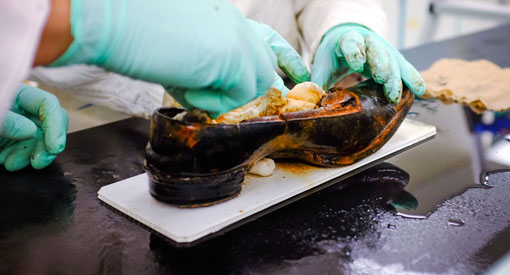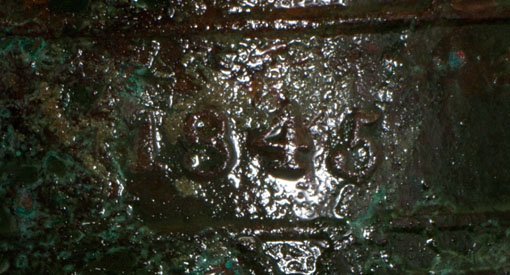
Artifact conservation
Wrecks of HMS Erebus and HMS Terror National Historic Site
From the sea to the lab

All artifacts retrieved from the wreck sites are first recorded by the archaeologists before they are excavated and taken to the laboratory in Ottawa for conservation treatment.
After the artifact is excavated, it can quickly deteriorate, causing the loss of many features of the artifact. The process of conservation begins as soon as the artifacts are out of the water. Taking the artifact from the sea to air and a dry environment can be very harmful to an artifact. We can keep newly excavated artifacts from deteriorating by maintaining similar conditions to those of the sea environment until it arrives at the laboratory.
We stabilize the artifacts by keeping them wet, dark and cold. Keeping artifacts cold while working in the arctic is easy but maintaining low temperatures during the trip to the lab can be challenging. The artifacts travel almost 3000 km from Nunavut to the laboratory in Ottawa.
Once the artifacts arrive at the lab, they are unpacked and their details are recorded and photographed thoroughly. Conservators check that the condition of each artifact is still stable.
Conservation and restoration

When the artifact is made from different materials (ex: glass, brass, wood, etc.), conservators need to make sure that treatment to clean one of the materials will not affect the other materials negatively. It’s important for the conservators to know and understand what the artifact is made of.
In the lab, the artifacts are gently cleaned of silt, seaweed and other marine life. It can be placed in an alkaline solution to remove the salt from the sea. This process can take many months but it is a very important step.
The solution is changed regularly until no more salt is detected. Once this is done, the artifact is rinsed and dried. The conservator careful cleans the rusted surfaces to show more details but the corrosion is not always all removed. Over-cleaning the rust from an artifact can result in losing some of the details or even reducing its authenticity.
The broad arrow and date of the bell recovered from HMS Erebus are actually preserved in the corrosion itself.
- Date modified :